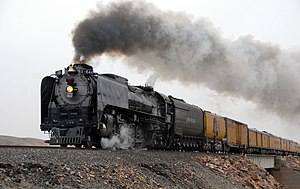
The American Locomotive Company was an American manufacturer that operated from 1901 to 1969, initially specializing in the production of locomotives but later diversifying and fabricating at various times diesel generators, automobiles, steel, tanks, munitions, oil-production equipment, as well as heat exchangers for nuclear power plants.

The Union Pacific Big Boy is a type of simple articulated 4-8-8-4 steam locomotive manufactured by the American Locomotive Company (ALCO) between 1941 and 1944 and operated by the Union Pacific Railroad in revenue service until 1962.

Under the Whyte notation for the classification of steam locomotives, 4-8-4 represents the wheel arrangement of four leading wheels on two axles, eight powered and coupled driving wheels on four axles and four trailing wheels on two axles. The type was first used by the Northern Pacific Railway, and initially named the Northern Pacific, but railfans and railroad employees have shortened the name since its introduction. It is most-commonly known as a Northern.
Under the Whyte notation for the classification of steam locomotives, 2-10-2 represents the wheel arrangement of two leading wheels, ten powered and coupled driving wheels, and two trailing wheels. In the United States and elsewhere the 2-10-2 is known as the Santa Fe type, after the Atchison, Topeka and Santa Fe Railway that first used the type in 1903.
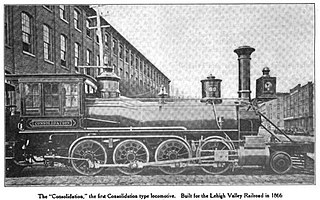
Under the Whyte notation for the classification of steam locomotives, 2-8-0 represents the wheel arrangement of two leading wheels on one axle, usually in a leading truck, eight powered and coupled driving wheels on four axles, and no trailing wheels. In the United States and elsewhere, this wheel arrangement is commonly known as a Consolidation, after the Lehigh and Mahanoy Railroad’s Consolidation, the name of the first 2-8-0.
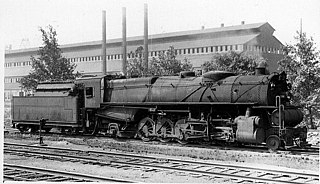
The Pennsylvania Railroad (PRR) N1s was a class of 2-10-2 "Santa Fe" steam locomotives built for the Pennsylvania's Lines West. 60 engines were built between December 1918 and November 1919, and worked heavy mineral freight to and from ports on the Great Lakes until their retirement in the late 1940s. All examples were scrapped by 1950.

In the Whyte notation for the classification of steam locomotives by wheel arrangement, a 2-8-8-0 is a locomotive with a two-wheel leading truck, two sets of eight driving wheels, and no trailing truck.

The GE U50 was an eight-axle, 5,000 hp (3,700 kW) diesel-electric locomotive built by GE Rail. They were twin-engined locomotives, combining two 2,500 hp (1,900 kW) diesel engines.

In the Whyte notation for classifying steam locomotives by wheel arrangement, a 4-6-6-4 is a railroad steam locomotive that has four leading wheels followed by two sets of six coupled driving wheels and four trailing wheels. 4-6-6-4's are commonly known as Challengers.
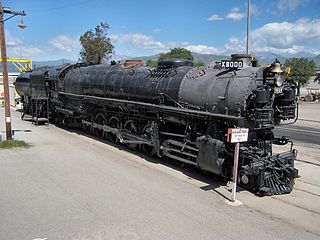
The Union Pacific Railroad 9000 Class was a class of 88 steam locomotives, built by ALCO for the Union Pacific between 1926 and 1930.

Union Pacific 844 is a class "FEF-3" 4-8-4 "Northern" type steam locomotive owned and operated by the Union Pacific Railroad for its heritage fleet. Built in December 1944 by the American Locomotive Company (ALCO) of Schenectady, New York, No. 844 is one of four surviving FEF series locomotives and the only one in operation.

Union Pacific 3985 is a four-cylinder simple articulated 4-6-6-4 "Challenger"-type steam locomotive built in July 1943 by the American Locomotive Company (ALCO) of Schenectady, New York, for the Union Pacific Railroad. No. 3985 is one of only two Challengers still in existence and the only one to have operated in excursion service.

The Union Pacific Challengers are a type of simple articulated 4-6-6-4 steam locomotive built by American Locomotive Company (ALCO) from 1936 to 1944 and operated by the Union Pacific Railroad until the late 1950s.
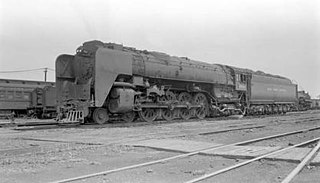
The New York Central Railroad's Niagara was a class of 27 4-8-4 steam locomotives built by the American Locomotive Company for the New York Central Railroad. Like many railroads that adopted different names for their 4-8-4s rather than “Northerns”, the New York Central named them “Niagaras”, after the Niagara River and Falls. It is considered as one of the most efficient 4-8-4 locomotives ever built.

The Chicago and North Western Class E-4 was a class of nine streamlined 4-6-4 "Hudson" steam locomotives built in 1937 by the American Locomotive Company (ALCO).

The Union Pacific GTELs were a series of gas turbine-electric locomotives built by Alco-GE and General Electric between 1952-1961 and operated by Union Pacific from 1952 to 1970.

Union Pacific 4014 is a steam locomotive owned and operated by the Union Pacific (UP) as part of its heritage fleet. It is a four-cylinder simple articulated 4-8-8-4 "Big Boy" type built in 1941 by the American Locomotive Company (ALCO) at its Schenectady Locomotive Works. It was assigned to haul heavy freight trains in the Wasatch mountain range. The locomotive was retired from revenue service in 1959 and was donated to the Railway & Locomotive Historical Society; thereafter, it was displayed in Fairplex at the RailGiants Train Museum in Pomona, California.

The Delaware & Hudson K-62 Class was a class of fifteen 4-8-4 steam locomotives built by the American Locomotive Company's Schenectady Works in 1943. They were intended as dual-service locomotives, hauling both freight and passenger trains until dieselization in 1953.

Union Pacific 5511 is a 2-10-2 “Santa Fe” type steam locomotive built by the Baldwin Locomotive Works in 1923 as part of the Union Pacific Railroad's TTT-6 class. It is the last remaining member of its class and the only remaining 2-10-2 to be operated by the Union Pacific.
